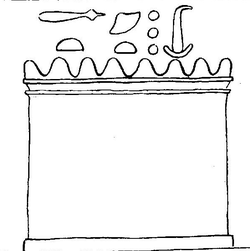Burnt offering (ancient egypt)
| Burnt offerings in hieroglyphics | |||||
|---|---|---|---|---|---|
| Old empire |
Udenet Wdn.t Make an offering to fire / consecrate to fire |
||||
| Altar of burnt offering to Thutmose III. ( Luxor ) | |||||
In ancient Egypt the burnt offering was one of the ritual offerings to important deities as a fire consecration and has been documented since the Old Kingdom . In the old cult of the king , it initially served as a way-opener for the oh , which after the burnt offering could begin its ascent from the grave into the northern sky .
In the further course of Egyptian history, the scent of the burnt offering also served as a general refreshment for the dead in the duat and as thanksgiving to various deities.
Mythological connections
In the Old Kingdom, the burnt offering was made to the heavenly gods Horus , Re , Hathor , Nechbet and Anubis . In the Middle Kingdom , Re-Harachte , Amun and Amun-Re were added. During the New Kingdom era , the burnt offerings were concentrated as thanksgiving to Amun-Re, Aton and Re-Harachte. Akhenaten finally declared Aton to be the all-embracing deity, which is why only Aton was given burnt offerings during his reign.
The development towards the cult of Aton has been clearly noticeable since the New Kingdom at the latest since Thutmose IV . In the grave of the night the burnt offering is “to a god who is not represented because his visible form is the incoming sunlight”. In Theban theology , Amun, Amun-Re and Re-Harachte up to Akhenaten (and afterwards) are officially the recipients of the burnt offerings.
The burnt offering was ritually reproduced in the graves without the population performing the sacred sacrifices of the priesthoods themselves. In addition, in those depictions it was not the king who was the focus, but the grave owner who made the symbolic sacrifice among his relatives .
Forms of burnt offerings
There were three ways of making burnt offerings: in raised burnt offering bowls, on raised burnt offering stands and on fire altars . Tools, offerings, flowers and charcoal were also part of the actions. Closely with the fire victims, the sacrifice connected. Already in the sun sanctuary of the Niuserre of the 5th dynasty there is a large and small slaughterhouse near an altar. However, it is unlikely that slaughtering actually took place there, as no access for the animals could be detected. At least the presence of the burnt offering facilities proves that burnt victims were known and committed in the earliest times.
The implements of the burnt offering were very valuable as consecration gifts. At the foundation of Thutmose III. the fire pans and altars were made of gold or silver . In the grave representations of the 18th dynasty , these tools are depicted in white or yellow. Assumptions that the victims actually were burnt victims have not been confirmed, as the equipment required for this was made of clay and always displayed in red.
See also
literature
- Jan Assmann : Death and the afterlife in ancient Egypt. Special edition. Beck, Munich 2003, ISBN 3-406-49707-1 .
- Siegfried Schott : The beautiful festival of the desert valley: Festival customs of a city of the dead . Publishing house of the Academy of Sciences and Literature, Mainz 1953
